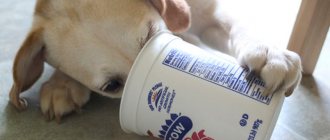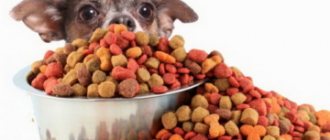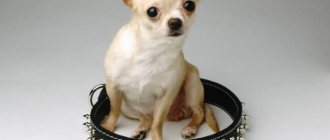Timing and signs of pregnancy in a Chihuahua
Normally, a Chihuahua's first birth occurs at one and a half years of age. The best time for a dog to whelp is from 1.5 to 4 years. At a more mature age, childbirth can lead to the death of the mother or cubs. The optimal weight of a bitch ready to whelp is from 1.5 to 2 kg. Dogs of this breed carry puppies for varying lengths of time, but give birth no earlier than 57 days and no later than 72 days after conception.
note
! In theory, childbirth is possible from 6-9 months of life, after the first heat has passed. But allowing childbirth at such an early age is dangerous. A pregnant Chihuahua will not only not give birth, but will not survive. Due to the physiological characteristics of this breed, early birth poses a great threat to the dogs’ lives.
Main symptoms of pregnancy:
- sudden weight gain;
- swollen mammary glands;
- enlarged belly;
- discharge of milk from the nipples.
On the 30th day after conception, obvious signs of pregnancy appear. But in very tiny babies it is difficult to determine the symptoms. For many, the weight remains within the normal range, but the tummy begins to increase during the last two weeks before giving birth. In order not to miss your Chihuahua's pregnancy, it is better to take your dog to the veterinarian. Make an appointment no earlier than two weeks after mating. About the “interesting position” of the dog can be said:
- Body temperature;
- special test;
- Ultrasound of the abdominal cavity.
The veterinarian performs a complete examination of the dog to make sure whether it is healthy or not.
Chihuahua pregnancy calendar by day
As stated above, the duration of pregnancy in a Chihuahua is 9 weeks, which is equivalent to 2 months. During this period of time, just a few cells in the mother's womb develop into perfectly formed puppies. Let's see what happens day after day in the womb of a pregnant Chihuahua until the puppies are born:
1-7 days (1st week)
Sperm rush down the fallopian tube towards the egg. Fertilization of the egg occurs, the formation of a zygote, and the first division. The vagina discharges or not, a clear or light pink mucous consistency is normal!
7-14 days (2nd week)
The cells begin to grow and divide, and tiny new embryos descend into the uterus. There they remain for the entire subsequent period of pregnancy. At the beginning of the 2nd week, the embryo consists of 4 cells, and at the end of 64 cells.
14-21 days (3rd week)
The embryos are implanted into the lining of the uterine wall, where they receive the vital nutrients and life support provided by the bitch's body. The size of the fetus at this stage does not exceed 1 centimeter. The nipples begin to enlarge, and there may be a decrease in appetite.
21-28 days (4th week)
A veterinarian or an experienced breeder can already feel the embryos in the womb with their fingers. The eyes and spine begin to develop, the muzzles take on their usual shape. The size of the fetus is approximately 1.5 cm. Within 4 weeks, the nipples swell, and mucous discharge from the vagina may be observed. A pregnant dog may vomit due to toxicosis. The fur on the belly and around the nipples is thinning. At 4 weeks, puppies are vulnerable to injury and developmental defects. Limit your dog from active play and strenuous exercise. Consult your veterinarian about diet and additional vitamin supplements.
Day 28-35 (5th week)
Around day 32, the level of amniotic fluid in the uterus increases to normal levels to protect the puppies from external threats. From now on, it is difficult to palpate the puppies by palpation of the abdomen. From the 5th week, puppies are less susceptible to defects and developmental disorders. Individual toes begin to form, claws and whiskers grow, and male and female genital organs develop. The bitch's weight at this stage of time begins to increase noticeably. This week you can do an ultrasound to determine the number and sex of the offspring.
What does temperature mean?
Body temperature is used to judge the number of days remaining before birth. Based on the obtained indicators, they can determine how long pregnant Chihuahuas walk and when the puppies will be born. During pregnancy, dogs experience 38 or 39o. This is the normal temperature for bearing offspring. But a week before giving birth, the temperature begins to change. A day before the birth of the puppies, it drops to 36o, and after birth it returns to normal.
Why do the test?
A pregnancy test is done through a blood draw. Laboratory testing determines the presence of relaxin. The placenta is responsible for the production of this hormone. She begins to produce it 15 days after the fertilized egg attaches to the wall of the uterus. By the fourth week of pregnancy, relaxin increases sharply and remains at this level until the dog gives birth. If relaxin is elevated, it means the Chihuahua is in an “interesting position.” The accuracy of the result is 99%.
note
! The test for the presence of relaxin is the only reliable diagnostic test that confirms the success of the mating and excludes false pregnancy.
Why do an ultrasound?
Thanks to an ultrasound performed after 40 days from the moment of conception, you will learn about the number of future puppies. Most often, dogs of this breed have a singleton pregnancy. During a multiple pregnancy, a Chihuahua can bear from 2 to 4 puppies weighing no more than 100 g. An ultrasound can tell you the number of puppies in the litter, their mobility and heartbeat.
How to help a pregnant Chihuahua?
When your Chihuahua is pregnant, follow a diary in which the owner’s actions are written down day by day.
Chihuahua Pregnancy Diary:
| Gestation period in days | Recommendations for owners |
| 1-15 | Avoid strenuous physical activity and long walks. If the air temperatures are too high or low, do not let the dog out of the house. Avoid overheating and hypothermia in your pets. |
| 16-25 | Give freedom to your pet. She may refuse food, active games, or walks. Protect her from noise, travel, interaction with strangers, contact with other dogs and other stressful situations. Give medications with the permission of the veterinarian. And most importantly, after the second week, take the dog to the veterinarian for a check-up to make sure the puppies are developing normally. |
| 26-35 | The dog's appetite will increase, but you should not overfeed it. Divide the daily intake into three equal portions and feed at the same time. |
| 36-50 | The daily food intake is slightly increased and divided into 5 equal portions. The diet includes food for pregnant and lactating dogs. Buy food designed for small breeds. If the Chihuahua does not eat dry food, then you need to increase the amount of meat and dairy products. |
| After 50 | Give your dog a larger place in the house. It should be warm, secluded and draft-free. Don't force her to eat if she refuses even her favorite treats. Normally, she should eat 3-4 times a day. Contact your veterinarian for advice on behavior in emergency situations. Learn about the procedure for long labor, weak labor, bleeding and other complications. |
Important
! Before giving your dog any vitamins, be sure to consult your veterinarian. With its help, you can create a detailed menu for the week.
How it manifests itself: signs and symptoms
It is not difficult to understand that a dog has toxicosis. It is accompanied by characteristic symptoms:
- lethargy;
- drowsiness;
- low temperature;
- nausea;
- vomit;
- loss of appetite;
- nervousness turning into aggression.
Find out about the pros and cons of Chappy dog food, as well as review the flavors and range of ready-to-eat food lines.
Read useful information about why a dog needs an international veterinary passport and how to fill out the document correctly at this address.
A pregnant dog begins to experience hormonal fluctuations already 3-4 days after mating. Her health can deteriorate almost instantly.
Owners need to pay attention to how often and how long the vomiting lasts, and to the nature of the vomit. It is better to record all changes in the animal’s condition. If necessary, show all records to the veterinarian.
What to feed a pregnant Chihuahua?
When the pregnancy reaches four weeks, increase the daily amount by 2% weekly. If the dog is accustomed to eating dry food, then after the first month the diet should contain food specially designed for pregnant women. When feeding naturally, more kefir, cottage cheese, vegetables and fruits are added to the diet.
Two weeks before giving birth, foods containing a lot of calcium and protein are excluded from the diet. But a week before giving birth, the dog is treated to rice or buckwheat porridge cooked in water. You can add a little to it:
- butter;
- crushed walnuts;
- grated raisins or dried apricots;
- apple pieces.
During this period of time, vegetables will be useful:
- zucchini;
- pumpkin;
- boiled cauliflower.
Vitamin and mineral supplements should be discussed with your veterinarian. It is better to discuss the menu of the last week before giving birth with your doctor.
What is a false pregnancy?
With a false pregnancy, a Chihuahua experiences all the symptoms that are characteristic of bearing offspring. The dog begins to act as if there are puppies in her womb. She is inactive, has poor appetite, enlarged nipples, a growing belly, and sometimes leaks colostrum or gastric distress.
False pregnancy can be caused by:
- mated to a sterile male;
- disruptions in hormonal levels or in the reproductive system;
- mental disorder;
- poor-quality sterilization, in which the ovary or part of it was preserved.
Only a doctor can determine whether a false or true pregnancy is present.
How can you tell when labor is starting?
Here's what you need to know about your Chihuahua's approaching due date:
- The dog becomes restless and changes in behavior. She begins to “dig” under the bedding or diaper in the birthing area, seeks privacy, or, on the contrary, attracts the attention of people.
- She has a rapid heartbeat, heavy breathing, and whitish discharge from the loop.
- The tummy begins to gradually drop, and colostrum appears on the nipples.
- The day before giving birth, your body temperature drops.
Based on these signs, you can guess that the puppies are about to be born.
Important
! The main sign of childbirth is considered to be a decrease in temperature.
How is childbirth?
Chihuahua labor can last up to 5 hours. Each subsequent puppy appears approximately an hour after the previous one. The intervals between the birth of puppies are almost the same. The birth is considered complete when more than 2 hours have passed since the last puppy.
A small dog needs the help of an owner who will be there at a crucial moment and monitor its condition. When contractions begin, be prepared to deliver the baby. Their onset is indicated by the sides, which begin to “walk” from side to side. Sidewalking refers to the movement of the puppy through the birth canal.
Before giving birth, the dog lies on its side and rests its paws against the wall of the maternity house. After the bladder ruptures, amniotic fluid comes out and labor begins. Contractions of the uterus increase in strength and occur more and more frequently each time.
When you deliver puppies, you may see them in the membranes. It does not always rupture while moving through the birth canal, so the Chihuahua chews it on its own.
To make the baby squeak, the mother stimulates his breathing and blood circulation by licking the puppy. The Chihuahua must chew the umbilical cord, lick the puppy, and eat the afterbirth that comes out after the puppy arrives.
Important
! Don't stop your dog from eating the afterbirth. She does this instinctively. If she does not chew the umbilical cord or membrane, then you need to help her do this. For cutting you will need disinfected scissors.
Preparing for childbirth
To take care of the dog’s well-being and get healthy offspring, the owner must choose a place in the apartment, prepare items according to the list and agree with the veterinarian about the possibility of visiting. The latter is especially important if this happens for the first time in an animal. It is recommended to give birth to a Chihuahua at home in an isolated room with curtained windows, where there is no noise or strangers.
Buy it at a pet store or build a birthing box. It should be the right size for your pet, have a removable side and be made of easy-to-clean material. Install the structure away from drafts and heating appliances. 2 weeks before the expected date of birth, bring the animal into an equipped room - this will help to get used to the place. One day before the start of the process, the bottom of the maternity box is covered with oilcloth, on which old bedding is placed (after the puppies appear, it is thrown away). From the 57th day of pregnancy, Chihuahuas must have their temperature measured twice a day. You should remove meat, fish and salt from your diet, and keep a bowl of clean water next to the box.
We recommend this article:
How to properly prepare and deliver a dog's baby
Before giving birth, the owner needs to put on comfortable old clothes, trim his nails and treat his hands with a disinfectant solution. During the process you will need syringes, a heating pad, a thermometer, pipettes, tweezers, scissors, cotton wool, medical alcohol, 5% glucose in ampoules, 10% synthomycin ointment, Traumeel, silk threads (for ligating the umbilical cord), scales, gauze napkins. Also prepare boxes for puppies and multi-colored threads to mark newborns, and a tray for sterile instruments. The woman in labor is washed, rinsing the genitals with warm water and soap, and treating them (including the vagina) with a solution of potassium permanganate. This drug is used in a ratio of 1:1000 (or furatsilin at a rate of 1:500).
Similar article: Description and behavioral characteristics of the miniature Chihuahua breed
How to care for a dog during the postpartum period?
After you finish delivering the baby, give the dog a break and gain strength, while you take care of the puppies. Weigh each of them and record the data obtained. Prepare a warm and clean bedding for the puppies to feed on. Place the dog on the bed. Place the puppies close to the mother's breast so that they can all suckle.
The room in which the puppies and their mother are located should be warm. Change the bedding to a new one every day. After a month, you can remove the house that was intended for puppies. Over three days, the puppies will lose a little weight, but this is within normal limits. The main thing is to control their feeding and make sure that all the babies are full.
After giving birth, pour warm tea with milk for the new mother. It needs to be washed and dried. After two hours, you can take her out for a 5-minute walk if the weather is dry outside. A walk is needed so that the dog can go to the toilet. Monitor breast emptying and nipple condition. The mammary glands should not be hard. If the dog is not able to feed the puppies, then buy special milk.
In the first week after giving birth, the Chihuahua should eat the same as before the birth of the babies. Warm tea diluted with milk and honey is added to food. After a week, they gradually give them lean meat and boiled fish.
note
! After giving birth, the bitch starts bleeding. The duration of this process should not be more than a week. If the discharge does not stop, changes color or smell, then you need to contact a veterinarian.
Treatment of toxicosis in dogs
A mild form does not require treatment; you can only help your pet cope with the condition by meeting her needs. Since bitches eat food selectively, you should offer them small quantities of different foods, but at the same time do not fill the bowl to the top with the food that the dog likes. Feeding standards must not be violated. There is no need to force feed your dog, especially trying to give him more meat. Excess protein is dangerous and leads to the development of diseases, such as tetany.
When contacting a veterinary clinic, the doctor will make a diagnosis and determine the degree of danger of the animal’s condition. Treatment may include the appointment of a drip infusion of an isotonic sodium chloride solution, a choline chloride solution, a glucose solution, the administration of insulin, biostimulants, and diuretics.











